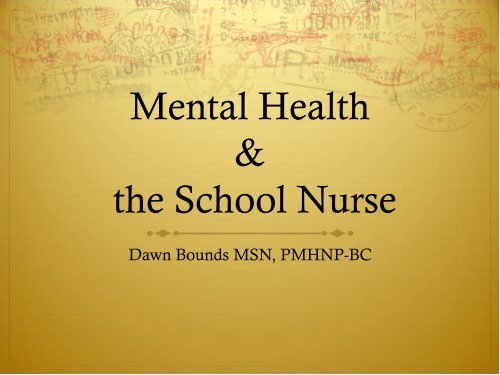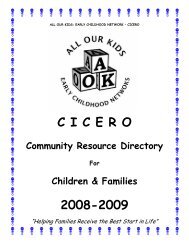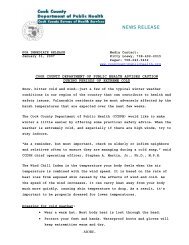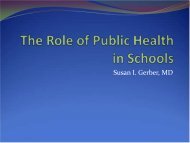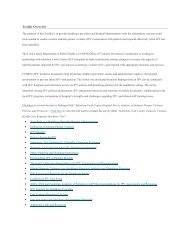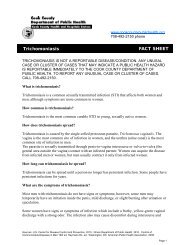Mental Health Assessment and Screening Tools - Cook County ...
Mental Health Assessment and Screening Tools - Cook County ...
Mental Health Assessment and Screening Tools - Cook County ...
You also want an ePaper? Increase the reach of your titles
YUMPU automatically turns print PDFs into web optimized ePapers that Google loves.
<strong>Mental</strong> <strong>Health</strong>&the School NurseDawn Bounds MSN, PMHNP-BC
Objectives Increase identification of mental health concerns amongststudents who present to the school nurse’s office Increase familiarity with assessment <strong>and</strong> screening toolsappropriate for use in the school nurse’s office Increase familiarity with appropriate interventions to use inthe school nurse’s office Increase identification of situations that necessitate a referral Increase ability to communicate confidential informationwhen necessary
Context State of mental health <strong>Mental</strong> health in schools School nurses are on the front line
The State of <strong>Mental</strong><strong>Health</strong> forChildren & Adolescents 1/5 experience S/S of amental health problemover a year Approximately 14million youth aged 18<strong>and</strong> under sufferedfrom one or moremental, emotional orbehavioral disorders in2008 Lifetime prevalence ofmental disorders is46.6% with halfemerging by age 14 <strong>and</strong>75% by 21
The State of <strong>Mental</strong> <strong>Health</strong> forChildren & Adolescents• Leading cause of disability in thoseages 15-44• The dem<strong>and</strong> for child mental healthservices is projected to increase 100%between 1995 <strong>and</strong> 2020• Untreated mental disorderscompromises development <strong>and</strong> placesyouth at risk for school failure,substance use, teen pregnancy,violence, suicide, <strong>and</strong> co-morbidpsychiatric <strong>and</strong> substance usedisorders• Only 20% with mental healthproblems receive services• 87% of uninsured children haveunmet mental health needs• 79% of children with private healthinsurance have unmet mental healthneeds
<strong>Mental</strong> <strong>Health</strong> in SchoolsSchools have become identifiers <strong>and</strong> treatment providers of mentaldisorders50% of youth with severe emotional disorders identify school astheir sole provider of these servicesChildren with mental health problems are frequent utilizers ofprimary care visits24% of pediatric primary care appointments involve psychosocialconcernsAmong privately insured children, 1/3 of mental health visits are totheir primary care providers <strong>and</strong> the majority of antidepressants <strong>and</strong>medications for ADHD are currently prescribed in primary care
<strong>Mental</strong> <strong>Health</strong> in Schools
School <strong>Mental</strong> <strong>Health</strong> Services in theUnited States, 2002–2003What’s being addressed <strong>and</strong> by who in schools had not been adequatelystudiedFirst study of its kind83,000 public elementary, middle <strong>and</strong> high schools in the US60% elementary19% middle18% high school3% combined schools
<strong>Mental</strong> <strong>Health</strong> Problems in Schools
Staffing for <strong>Mental</strong> <strong>Health</strong> Servicesin Schools
Variety of Staff who Provide<strong>Mental</strong> <strong>Health</strong> Services
The Current Child <strong>Mental</strong> <strong>Health</strong>Workforce Crisis Aging child psychiatry workforce Not enough medical students entering child psychiatry There are about 7,400 child psychiatrists actively practicing inthe United States Only 300 child psychiatrists complete formal education <strong>and</strong>training annually Shortage of child/adolescent psychiatric providers Inequitable distribution of these providers to largemetropolitan areas
Yes…It’s Normal for Adolescents To...(APA, 2002) Argue for the sake of arguing Jump to conclusions Be self-centered Constantly find fault in the adult’sposition Be overly dramatic
Vital <strong>Assessment</strong>s Assess for suicide BUT remember not all cutting issuicide Plan Intent Means Access History Functioning – attendance, grades, disciplinary referrals Get collateral info – teachers, staff, parents
Useful <strong>Tools</strong> GLAD-PC http://www.glad-pc.org/ Bright Futures www.brightfutures.org Motivational Interviewingwww.motivationalinterview.org Remember OARSOpen-ended questionsAffirmationsReflectionsSummaries
Tips for Talking With Adolescents(APA, 2002) Engage adolescents with non-threatening questions. Listen non-judgmentally (<strong>and</strong> listen more than you speak). Ask open-ended questions. Avoid “why” questions. Match the adolescent’s emotional state, unless it is hostile. Casually model rational decision-making strategies. Discuss ethical <strong>and</strong> moral problems that are in the news.
Interventions Become an assets-builder (it’s all about resilience!) Influence school culture Encourage good sleep hygiene Encourage good eating habits
Resilience “Developing resilience at school improves academicperformance <strong>and</strong> strengthens students’ abilities toovercome obstacles in all aspects of life. The mosteffective methods of deterring at-risk students fromfuture misbehavior rest in establishing mutual respect<strong>and</strong> building relationships with them by being visible<strong>and</strong> available, by communicating with them to get to theroot of their real problems <strong>and</strong> referring them to theappropriate resources for help” (Parker, 2007).
Developmental AssetsTheory Search Institute: http://www.searchinstitute.org/assets/40AssetsList.pdf 8 categories of Developmental Assets 20 External <strong>and</strong> 20 Internal 40 Developmental Assets “Crucial categories of influence that time <strong>and</strong> again have beenshown to meaningfully shape young people’s developmentalpathways” (Scales & Leffert, 2004, p.13). Increases resilience
Developmental Assets Theory:SupportLove, Affirmation, AcceptanceFamily supportPositive family communicationOther adult relationshipsCaring neighborhoodCaring school climateParent involvement in schooling“Urban Sanctuaries”
Developmental Assets Theory:Empowerment Community values youth Youth as resources Service to others Safety“Benson (1997) warns that asset building in general is lessabout programs than it is about community membersmobilizing to ‘build sustained, informal positive relationships’(p.93) with young people” (Scales & Leffert, 2004, p.71).
Referrals Know when it is a crisis, when it isn’t, <strong>and</strong> when it is notup to you to decide Call SASS on the CARES Line for Crises Use the resources in the building Know your community
Communication Use a release Only provide necessary information Introduce student to who you’d like to communicatewith <strong>and</strong> let them communicate for themselves in yourpresence
References Cartoons - http://www.dubuque.k12.ia.us/cartoons Foster S, Rollefson M, Doksum T, Noonan D, Robinson G.(2005). School <strong>Mental</strong> <strong>Health</strong> Services in the United States, 2002–2003. DHHS Pub. No. (SMA) 05-4068. Rockville, MD: Centerfor <strong>Mental</strong> <strong>Health</strong> Services, Substance Abuse <strong>and</strong> <strong>Mental</strong><strong>Health</strong> Services Administration. Retrievedfromhttp://mentalhealth.samhsa.gov/publications/allpubs/sma05-4068/chap1.asp#_Toc111868245 Parker, D. (2007). Developing <strong>and</strong> Saving Relationships…<strong>and</strong>Students that may be At-Risk. Scales & Leffert (2004). Developmental Assets: A Synthesisof the Scientific Research on Adolescent Development.
Dawn Bounds MSN, PMHNP-BCRush University, College of Nursing708-334-3296Dawn_T_Bounds@rush.edu


